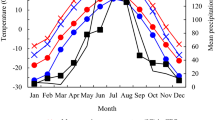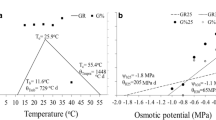Abstract
The ability to germinate under a variety of environmental conditions is essential for plant species inhabiting a wide range of altitudes and latitudes. Phacelia secunda J. F. Gmel. (Hydrophyllaceae) is a perennial herb with wide latitudinal and altitudinal distributional ranges. In the central Chilean Andes (33 °S) P. secunda can be found from 1600 m sealevel up to the vegetation limit at 3400 m. It has been suggested that seeds from populations encountering long periods with snow cover and adverse winter conditions would require longer periods of cold stratification for germination than those from populations exposed to milder winters. Given that the snow-free period decreases with elevation, seeds from high elevation populations could require longer period of cold stratification to germinate. Moreover, it has been shown that seeds from arctic and higher elevations environments are adapted to germinate better under high temperature conditions. Germination response with increasing periods of cold stratification (0–6 mo.) and under two contrasting thermoperiods (20 °/1O °C; 10 °/5 °C; 12 h day/night), were studied for 4 populations of P. secunda located at 1600, 2100, 2900 and 3400 m a.s.l. Initiation of germination required increasingly longer periods of stratification with elevation, and proportionately fewer seeds germinated for any one stratification treatment at the higher elevations. Seeds from higher elevations germinated to a higher percentage under the high than the low temperature thermoperiods. These results illustrates a significant variation in germination characteristics over a spatially short environmental gradient.
Similar content being viewed by others
References
Amen, R. D. 1966. The extent and role of seed dormancy in alpine plants. Quart. Rev. Biol. 41: 271–281.
Angevine, M. W. & Chabot, B. F. 1979. Seed germination syndromes in higher plants. Pp. 188–206. In: O. T. Solbrig, Jain, S., Johnson, G. B. & Raven, P. (eds) Topics in Plant Population Biology. Columbia University Press, New York.
Arroyo, M. T. K. & Uslar, P. 1993. Breeding systems in temperate mediterranean-type climate montane slcerophyllous forest in central Chile. Botan. J. Linn. Soc. 111: 83–102.
Arroyo, M. T. K., Annesto, J. J., & Villagrán, C. 1981. Plant phonological patterns in the high Andean cordillera of central Chile. J. Ecol. 69: 205–223.
Barclay, A. M. & Crawford, R. M. 1984. Seedling emergence in the Rowan (Sorbus aucuparia) from an altitudinal gradient. J. Ecol. 72: 627–636.
Baskin, C. C. & Baskin, J. M. 1998. Seeds. Ecology, Biogeography, and Evolution of Dormancy and Germination. Academic Press, San Diego.
Bell, K. & Bliss, L. C. 1980. Plant reproduction in a high arctic environment. Arctic and Alpine Res. 12: 1–10.
Bewley, J. D. & Black, M. 1982. Physiology and Biochemistry of Seeds. 2. Viability, Dormancy, and Environmental Control. Springer-Verlag, Berlin.
Billings, W. D. 1974. Adaptations and origins of alpine plants. Arctic and Alpine Res. 6: 129–142.
Billings, W. D. & Mooney H. A. 1968. The ecology of arctic and alpine plants. Biolog. Rev. 43: 481–529.
Bliss, L. C. 1985. Alpine. Pp. 41–65. In: Billings, W. D. & Mooney HA. (eds) Physiological Ecology of North American Plant Terrestrial Communities, Chapman and Hall, New York.
Borghetti, M., Vendramin, G. G., Giannini, R. & Schettino, A. 1989. Effects of stratification, temperature, and light on germination of Pinus leucodermis. Acta Oecologia, Oecologia Plantarum 10: 45–56.
Cavieres, L. A., Peñ aloza, A. & Arroyo, M. T. K. in press. Altitudinal vegetation belts in the high Andes of central Chile (33°S). Rev. Chil. Hist. Nat.
Cavieres, L. A. 1999. Bancos de semillas y estrategias de germinació n en Phacelia secunda J. F. Gmel (Hydrophyllaceae): variaciones a lo largo de un gradients altitudinal en los Andes de Chile central. Tesis de Doctorado, Facultad de Ciencias, Universidad de Chile.
Cavieres, L. A. 2000. Variació n morfoló gica de Phacelia secunda J. F. Gmel. (Hydrophyllaceae) a lo largo de un gradient altitudinal en Chile central. Gayana Botanica 37: 1–8.
Cavieres, L. A., Peñ aloza, A., Papic, C. & Tambutti, M. 1998. Efecto nodriza del cojín Laretia acaulis (Cav.) Gill. et Hook. (Umbelliferae) en la zona alto-andina de Chile central. Revista Chilena de Historia Natural 71: 337–347.
Chabot, B. & Billings, W. 1972. Origin and ecology of the Sierran alpine vegetation. Ecolog. Monog. 42: 163–199.
Deginani, N. B. 1982. Revisió n de las especies argentinas del género Phacelia (Hydrophyllaceae). Darwiniana 24: 405–496.
Dorne, A. 1981. Variation in seed germination inhibition of Chenopodium bonus-henricus in relation to altitude of plant growth. Can. J. Botany 59: 1893–1901.
Grime, J. P., Manson, G., Curtis, A. V., Rodman, J., Band, S. R., Mowforth, M. A. G., Neal, N. A., & Shaw, S. 1981. A comparative study of germination characteristics in a local flora. J. Ecol. 69: 1017–1059.
Harper, J. 1977. Population Biology of Plants. Academic Press, New York.
Hendry, G. A. & Grime, J. P. 1993. Methods in Comparative Plant Ecology. Chapman & Hall, London.
Inoue, K. & Washitani, I. 1989. Geographical variation in thermal germination responses in Campanula punctata Lam. Plant Spec. Biol. 4: 69–74.
Kibe, T. & Masuzawa, T. 1994. Seed germination and seedling growth of Carex doenitzii growing on alpine zone of Mt. Fuji. J. Plant Res. 107: 23–27.
Marchand, P. J. & Roach, D. A. 1980. Reproductive strategies of pioneering alpine species: seed production, dispersal and germination. Arctic and Alpine Res. 12: 137–146.
Meyer, S. & Monsen, S. B. 1991. Habitat-correlated variation in mountain big sagebrush (Artemisia tridentata ssp. vayesana) seed germination patterns. Ecology 72: 739–742.
Meyer, S. & Kitchen, S. G. 1994. Life history variation in blue fax (Linum perenne: Linaceae): seed germination phenology. Amer. J. Botany 81: 528–535.
Meyer, S., McArthur, E. D. & Jorgesen, G. 1989. Variation in germination response to temperature in Rubber rabbitbrush. (Chrysothamnus nauseosus, Asteraceae,) and its ecological implications. Amer. J. Botany 76: 981–991.
Meyer, S., Monsen, S. B. & McArthur, D. E. 1990. Germination response of Artemisia tridentata (Asteraceae) to light and chill: Patterns of between-population variation. Botanical Gazette 151: 176–183.
Meyer, S., Allen, P. S. & Beckstead, J. 1997. Seed germination regulation in Bromus tectorum (Poaceae) and its ecological significance. Oikos 78: 475–485.
Nikolaeva, M. G. 1969. Physiology of Deed Dormancy in Seed. lzdatel'stuo Nauka, Leningrad.
Peñ aloza, A. 1996. Consideraciones microclimáticas en la sobrevivencia de semillas y plántulas de Kageneckia angustifolia Don una especie del bosque montano de Chile central. Tesis de Magister, Facultad de Ciencias, Universidad de Chile.
Potvin, C. 1994. ANOVA: Experiments in controlled environments. Pp 46–88, In: Scheiner, S. & Gurevitch, J. (eds) Design and Analysis of Ecological Experiments. Chapman and Hall, New York.
Reynolds, D. N. 1984. Alpine annual plants: phonology, germination, photosynthesis, and growth of three Rocky Mountain species. Ecology 65: 759–766.
Sayers, R. L. & Ward, R. T. 1966. Germination responses in alpine species. Botanical Gazette 127:11–16.
Schütz, W. & Milberg, P. 1997. Seed dormancy in Carex canescens: regional differences and ecological consequences. Oikos 78: 420–428.
Steel, R. & Torrie, J. 1988. Bioestadistica: Principios y Procedimientos. McGraw- Hill, México.
Venable, D. L. 1984. Using intraespecific variation to study the ecological significance and evolution of plant life-histories. Pp 166–186. In: Dirzo, R. & Sarukhán, J. (eds) Perspectives on Plant Population Ecology. Sinauer, Sunderland.
Author information
Authors and Affiliations
Rights and permissions
About this article
Cite this article
Cavieres, L.A., Arroyo, M.T. Seed germination response to cold stratification period and thermal regime in Phacelia secunda (Hydrophyllaceae) – Altitudinal variation in the mediterranean Andes of central Chile. Plant Ecology 149, 1–8 (2000). https://doi.org/10.1023/A:1009802806674
Issue Date:
DOI: https://doi.org/10.1023/A:1009802806674




